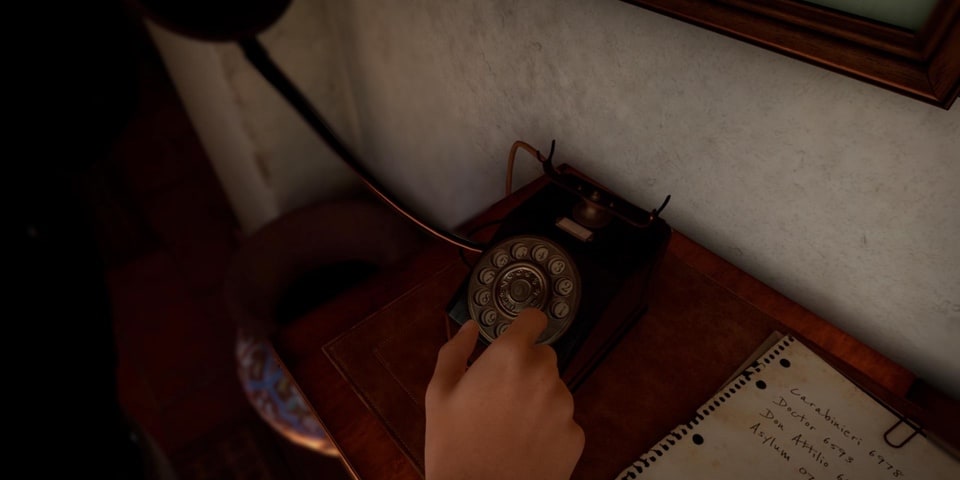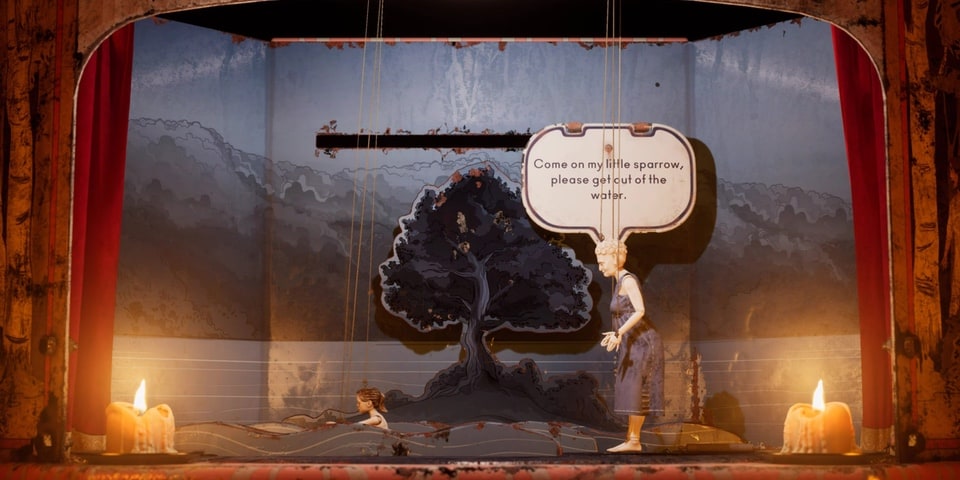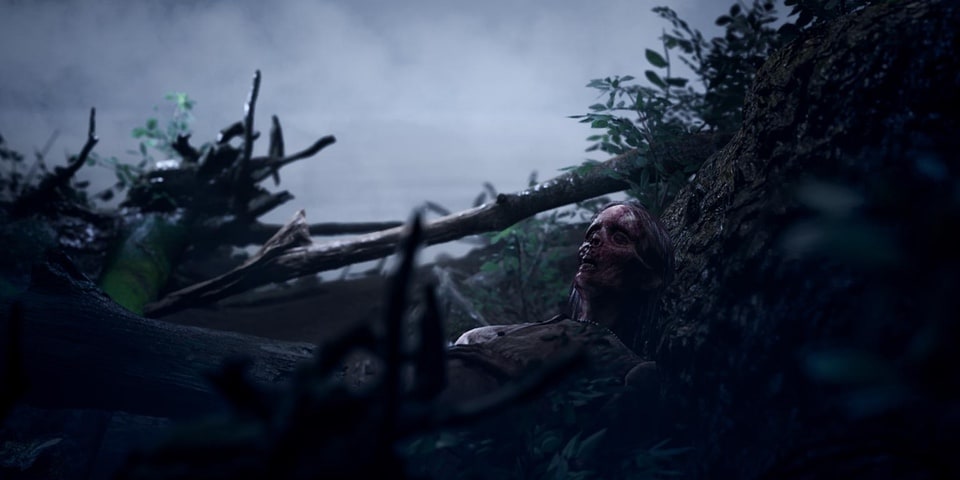Martha is Dead tells the harrowing story of Giulia, the daughter of a German officer living in a picturesque Italian villa who discovers her sister, Martha, has been murdered. What follows is a psychologically horrific trip through the mind of Giulia, where dreams and reality are blurred as she tries to discover the truth about what happened to Martha while also trying to deal with the trauma of her death.
It’s a game that seeks to go beyond mere horror and tell a story with an important message, the problem is that I came away from it not sure what story it’s trying to tell, but knowing that it’s not been told very well.
Akin to games like Gone Home and Firewatch, Martha is Dead plays like a walking simulator, but with a lot of variable interactive elements – the main element being photography with a 1940s camera. In order to proceed with the story, as you explore the beautiful Italian countryside, you are tasked with taking photographs on a classic camera with a bunch of attachments, making sure you get the perfect shot. Taking these photos can uncover hidden mysteries and lead to some startling revelations.
The whole process is very well represented in the game. I don’t know much about photography, but being able to make adjustments to the focus and mess around with different lenses was neat. It’s basically a modern video game photo mode but with direct relation to the actual equipment.
Once you’ve taken the photos, you need to go into the darkroom of your house and develop them, once again adding a layer of realism to the experience. You need to adjust the paper, make sure the image fits and then expose it with light, before developing it in fluid and making sure you don’t overdevelop, otherwise you have to start the process again.

After initially feeling unsure what kind of game I was playing, I started to get comfortable with Martha is Dead being a weird photography simulator. My expectations quickly changed as more ‘mini games’ became part of the baseline experience. One segment involves you sending coded messages, requiring you to learn morse code, which I also found pretty neat.
Sadly the rest of the experience is not as exciting and actually quite frustrating. It’s lovely to absorb your surroundings as you wander around the estate, but when you’re trying to go from A to B to complete objectives, the way that paths are (or aren’t) laid out and getting caught on the scenery had me tear my hair out as I could not progress forward in some segments. At one point I had to reload a checkpoint because I found my way to a river and could not get back out again.
There‘s a large forested area by the villa which takes a lot of time to travel through and this is the most frustrating part. It’s deceptive in the fact that there are certain parts of the woods you can walk through and others you cannot. Spending an hour trying to figure out where I was going was not fun. There’s a main path which leads you directly to the lake, but exploring the other parts was tiresome. What made it worse is when you finally reached the objective laid out on your map, the game simply would not let you continue with the said objective, having clicked on the hand multiple times. It just didn’t do anything…
You also have a few on-rails sections where you are flying through a dream state and have to choose paths to progress down. Selecting the wrong path just resets you back to the beginning until you get it right. It felt a bit pointless. It’s so frustrating as every time I’d enjoy one part of the game, another would come along and sully the experience of solving the overarching mystery.

Repressed memories of Guilia are discovered through playing with marionettes in a small theatre. You take turns in controlling the characters and choosing how they respond with dialogue and action options. This mechanic comes late in the game as Guilia starts remembering more about past events, forcing you to play and witness slightly uncomfortable scenes from her family history. This is of course a subtle dive into the darkness and I think if left here, might have served the game’s story and message better. Instead, Martha is Dead takes it a bit too far.
The story is intended to keep the player in a state of tension, but as a psychological thriller I think it failed to hit the mark. A lot of what’s included feels ham-fisted and there for the sake of shock value. In recent news, the PlayStation versions were censored, removing a particular scene. As I played, I second guessed myself which scene it could be until I saw a warning on screen asking if I wanted to view the censored version of what was about to happen. All I can say is that it’s not something any player should be forced to do as part of a gaming narrative. It is important that we are able to talk about difficult subjects and I see the point that developer LKA were trying to make, but they definitely could have done it better.
Thankfully, not much phases me, so I walked away unaffected by what I saw. A lot of people, however, should tread carefully when playing this. It’s probably the darkest game I’ve ever played.

Graphically, Martha is Dead is very pretty, on the outside anyway. The visuals are mostly too dark to appreciate inside the home, but walking around in the sunlight looks nice enough and does a good job of recreating a real Italian villa and inserting you into 1944 Italy – there’s newspapers to read on the table, the radio playing appropriate music, and so on. The game is also set to Italian audio with subtitles by default, though this can be changed if needed.
Undercutting this, the framerate is variable when playing on Xbox Series X, seemingly running at smooth 60fps indoors and slowing down to 30fps outside. It’s ridiculously jarring and a touch annoying. Additionally, I completed Martha is Dead in just over six hours, but I’d say that half of that was aimless wandering trying to find objectives and restarting sections because of bugs. I don’t often regret time spent gaming, but I feel like I wasted my time here.
On paper, Martha is Dead sounds fantastic and a true opportunity to explore something unique that’s not really been seen in video games before. Video games are an artistic medium and therefore should be treated in the same regards as any kind of comic, movies or the like. They have incredible potential to tell engaging stories, but if it’s not done well it just creates frustration and ends up leaving a sour taste and a feeling of wasted potential.
- About
- Action
- adjustments
- All
- Another
- AREA
- around
- audio
- Baseline
- beautiful
- before
- Bit
- bugs
- Bunch
- caught
- characters
- code
- continue
- dead
- deal
- develop
- Developer
- developing
- different
- discover
- discovered
- down
- dreams
- ends
- equipment
- estate
- events
- experience
- family
- Figure
- Finally
- Focus
- Forward
- fun
- game
- Games
- Gaming
- good
- Hair
- having
- here
- hidden
- history
- Home
- House
- How
- HTTPS
- i
- image
- important
- Included
- interactive
- IT
- Italian
- Italy
- Job
- large
- launch
- lead
- LEARN
- light
- Making
- map
- mark
- medium
- Modern
- more
- Movies
- Music
- Neat
- news
- Newspapers
- Officer
- Opportunity
- Options
- order
- Other
- Paper
- People
- photography
- photos
- play
- player
- Playing
- playstation
- potential
- Process
- Radio
- RE
- Reality
- REST
- review
- running
- s
- Said
- Screen
- segments
- Series
- set
- simulator
- SIX
- Slowing
- small
- So
- Spending
- start
- started
- State
- Stories
- Story
- sunlight
- tells
- The
- theatre
- Through
- time
- touch
- travel
- uncover
- unique
- value
- version
- Video
- video games
- View
- walking
- What
- WHO
- X
- xbox
- Xbox Series X
- youtube











